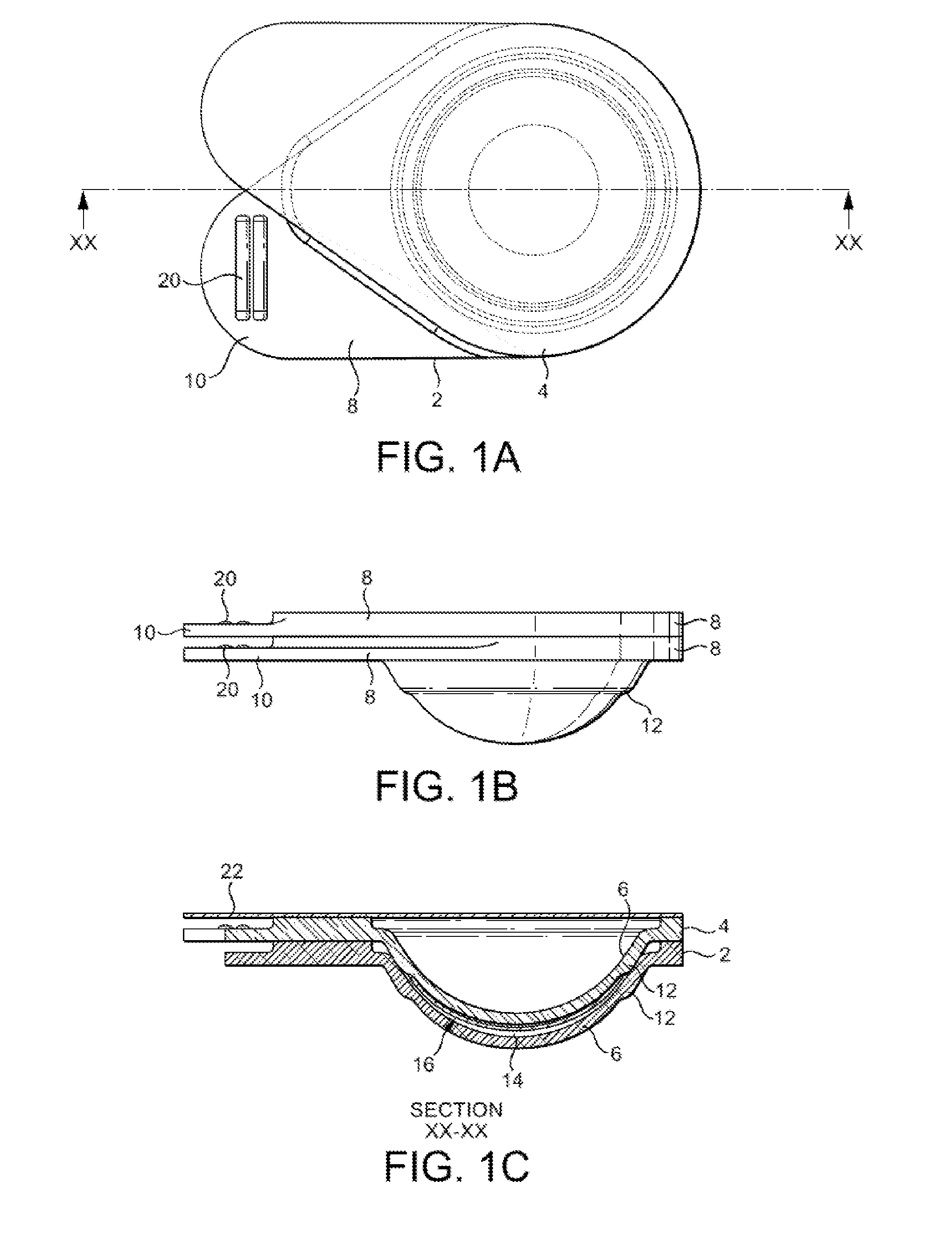Contact lens packaging
a technology for contact lenses and packaging, applied in the field of contact lens packaging, can solve the problems of lenses not resuming the desired curvature for optimum fit and/or optical correction, and the packaging disclosed therein is not useful for providing hydrogel contact lenses in a ready-to-wear form, so as to reduce the likelihood of spillage or mess
- Summary
- Abstract
- Description
- Claims
- Application Information
AI Technical Summary
Benefits of technology
Problems solved by technology
Method used
Image
Examples
example 2
[0057]With reference to FIGS. 2A & 2B, this example describes in greater detail the application of adhesive to the adjacent packages.
[0058]FIG. 2A shows a plan view looking down onto the upper surface of a package, identical to the embodiment illustrated in FIGS. 1A-1C. FIG. 2B is a plan view of the underside of the package. Parts equivalent to those in FIGS. 1A-1C are denoted by common reference numerals.
[0059]As explained elsewhere, the choice of adhesive may be determined at least in part by the choice of material used to form the packages. However, in a preferred embodiment, one side of the package will be formed (typically, moulded) so as to have a relatively rough surface. The other side of the package will be formed so as to have a relatively smooth surface. The adhesive composition will adhere preferentially to the relatively rough surface.
[0060]With reference to FIG. 2A, an annular part 30 on the upper surface of the peripheral portion 8 is formed with a relatively smooth s...
example 3
[0068]Referring to FIGS. 5A-5C, there is shown a holder for holding a stack of individually separable contact lens packages in accordance with the invention. More especially the holder is adapted and configured to hold a stack of the sort illustrated in FIGS. 4A-C.
[0069]The holder 50 is formed from a mouldable synthetic plastics material and comprises a flat, essentially horizontal base, 52, integrally formed with curved front and back upright members 54, 56 respectively. The upright members 54, 56 define between them a substantially vertical channel or groove within which the stack 58 of contact lens packages is accommodated. The inner face of the front upright member 54 is formed with two shallow indentations to accept the projecting flange portions of the left and right handed packages. The holder is also provided with an optional lid 60, which is slidably received within the same channel or groove which accommodates the stack of packages 58, the profile of the lid 60 being suita...
example 4
[0073]This example relates to an alternative arrangement of contact lens packages in a stack, as illustrated in FIGS. 8A-C.
[0074]In this embodiment, the individual packages are generally as shown in FIG. 1. However, the packages are all identical in shape and do not exist in left- or right-handed forms.
[0075]Instead, the individual packages are formed into a stack in which the projecting flange portions 10 are arranged so as to process in a manner rotating around the stack. In the embodiment shown, each flange portion is marked with a day of the week, the packaged lenses being intended for daily wear and subsequent disposal. The stack is arranged so as have rotational symmetry of order 7, such that the contact lens packages corresponding to a particular day of the week occupy the same relative rotational position within the stack.
[0076](Note that FIG. 8C is drawn to a different scale relative to FIGS. 8A & 8B).
PUM
 Login to View More
Login to View More Abstract
Description
Claims
Application Information
 Login to View More
Login to View More - R&D
- Intellectual Property
- Life Sciences
- Materials
- Tech Scout
- Unparalleled Data Quality
- Higher Quality Content
- 60% Fewer Hallucinations
Browse by: Latest US Patents, China's latest patents, Technical Efficacy Thesaurus, Application Domain, Technology Topic, Popular Technical Reports.
© 2025 PatSnap. All rights reserved.Legal|Privacy policy|Modern Slavery Act Transparency Statement|Sitemap|About US| Contact US: help@patsnap.com



